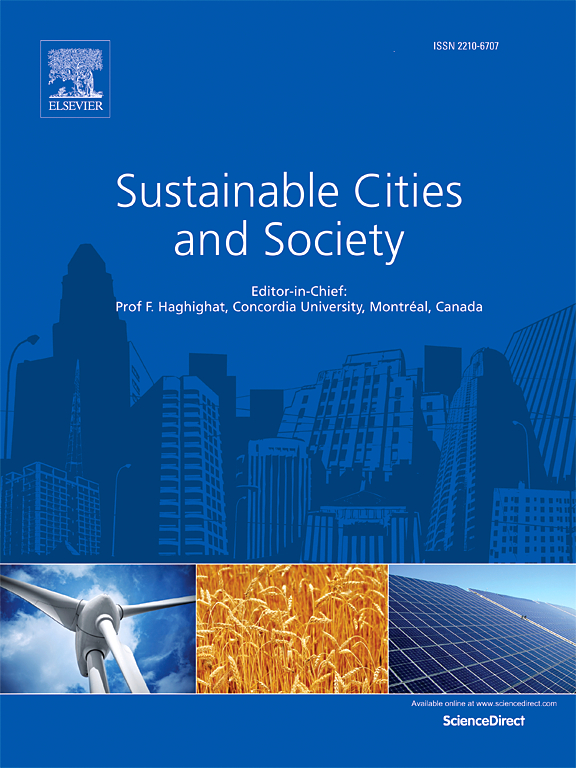中国中老年人心理健康与地理环境的非线性关系及空间异质性
IF 10.5
1区 工程技术
Q1 CONSTRUCTION & BUILDING TECHNOLOGY
引用次数: 0
摘要
“地理环境与心理健康”之间的非线性动态和空间异质性是正在进行的理论辩论和经验差异的关键因素。然而,现有的分析往往是碎片化的,并受到诸如线性模型的优势、多重共线性和忽略变量偏差等问题的限制。本研究采用极端梯度增强(XGBoost)模型和SHapley加性解释(SHAP)来研究自然环境、建筑环境和社会环境对中国中老年人心理健康的非线性效应、空间变异性和相互作用,从而弥补了这些空白。结果表明,地理环境因子对心理健康的影响呈非线性关系,其中最高气温、NDVI、人口密度和人均公园绿地面积对心理健康的影响最为显著。它们的定向影响和边际效应遵循不同的趋势。地理环境因素对心理健康既有独立的影响,又有复杂的相互作用。此外,地理环境变量与心理健康的关系具有显著的空间异质性。K-means聚类分析进一步确定了地理环境因素对心理健康影响不同的四个不同区域。这些结果为解决理论争议、理解经验差异以及为城市规划、景观建筑和环境管理策略提供了有价值的见解。本文章由计算机程序翻译,如有差异,请以英文原文为准。
Nonlinear relationships and spatial heterogeneity between geographical environment and mental health among middle-aged and older adults in China
The nonlinear dynamics and spatial heterogeneity between the "geographical environment and mental health" represent pivotal elements in ongoing theoretical debates and empirical discrepancies. However, existing analyses are often fragmented and constrained by issues such as the predominance of linear models, multicollinearity, and omitted variable bias. This study bridges these gaps by employing the eXtreme Gradient Boosting (XGBoost) model and SHapley Additive exPlanations (SHAP) to examine the non-linear effects, spatial variability, and interactions of the natural, built, and social environments on the mental health of middle-aged and older adults in China. The findings reveal that nearly all geographical environmental factors exhibit non-linear relationships with mental health, with maximum temperature, NDVI, population density, and per capita park green space area showing the most pronounced effects. Their directional impact and marginal effects follow divergent trends. Geographical environmental factors not only exert independent effects on mental health but also interact in complex ways. Moreover, the relationship between geographical environmental variables and mental health displays significant spatial heterogeneity. K-means clustering analysis further identifies four distinct regions where geographical environmental factors differentially influence mental health. These results offer valuable insights for resolving theoretical disputes, understanding empirical variations, and informing urban planning, landscape architecture, and environmental management strategies.
求助全文
通过发布文献求助,成功后即可免费获取论文全文。
去求助
来源期刊

Sustainable Cities and Society
Social Sciences-Geography, Planning and Development
CiteScore
22.00
自引率
13.70%
发文量
810
审稿时长
27 days
期刊介绍:
Sustainable Cities and Society (SCS) is an international journal that focuses on fundamental and applied research to promote environmentally sustainable and socially resilient cities. The journal welcomes cross-cutting, multi-disciplinary research in various areas, including:
1. Smart cities and resilient environments;
2. Alternative/clean energy sources, energy distribution, distributed energy generation, and energy demand reduction/management;
3. Monitoring and improving air quality in built environment and cities (e.g., healthy built environment and air quality management);
4. Energy efficient, low/zero carbon, and green buildings/communities;
5. Climate change mitigation and adaptation in urban environments;
6. Green infrastructure and BMPs;
7. Environmental Footprint accounting and management;
8. Urban agriculture and forestry;
9. ICT, smart grid and intelligent infrastructure;
10. Urban design/planning, regulations, legislation, certification, economics, and policy;
11. Social aspects, impacts and resiliency of cities;
12. Behavior monitoring, analysis and change within urban communities;
13. Health monitoring and improvement;
14. Nexus issues related to sustainable cities and societies;
15. Smart city governance;
16. Decision Support Systems for trade-off and uncertainty analysis for improved management of cities and society;
17. Big data, machine learning, and artificial intelligence applications and case studies;
18. Critical infrastructure protection, including security, privacy, forensics, and reliability issues of cyber-physical systems.
19. Water footprint reduction and urban water distribution, harvesting, treatment, reuse and management;
20. Waste reduction and recycling;
21. Wastewater collection, treatment and recycling;
22. Smart, clean and healthy transportation systems and infrastructure;
 求助内容:
求助内容: 应助结果提醒方式:
应助结果提醒方式:


